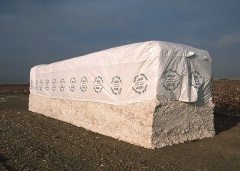Cotton
From Cargo Handbook - the world's largest cargo transport guidelines website
| Infobox on Cotton | |
|---|---|
| Example of Cotton |  |
| Facts | |
| Origin |
|
| Stowage factor (in m3/t) |
|
| Humidity / moisture |
|
| Oil content | 0.4 - 1.0% (waxes) |
| Ventilation | If the product is loaded for shipment in a dry state, it does not have any particular ventilation requirements. Problems arise if the product, packaging and/or flooring/ceiling are too damp or the temperature is too high. The heat has then to be dissipated and ventilation should proceed as follows: - Air exchange rate: 6 changes/hour (airing) - Moisture must then be eliminated, to reduce mold and bacterial activity. - Since cotton very readily absorbs oxygen, before anybody enters the hold, it must be ventilated and a gas measurement carried out, since a shortage of oxygen may endanger life. |
| Risk factors | Reference is made to the relevant IMO regulations on hazardous cargo. |











